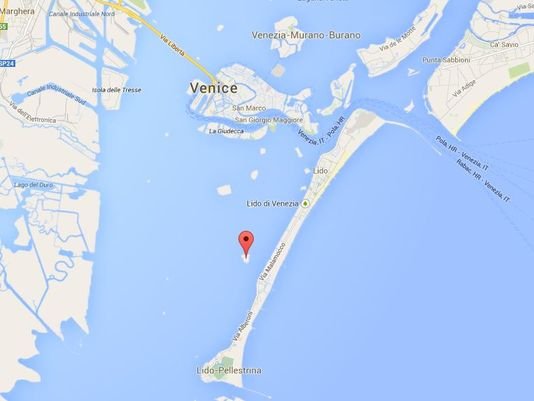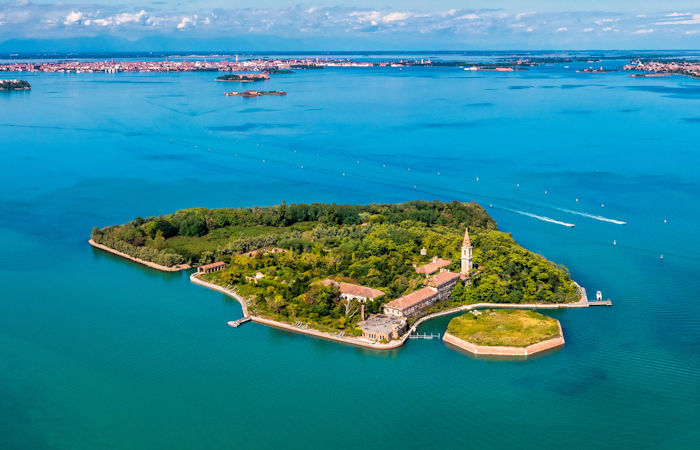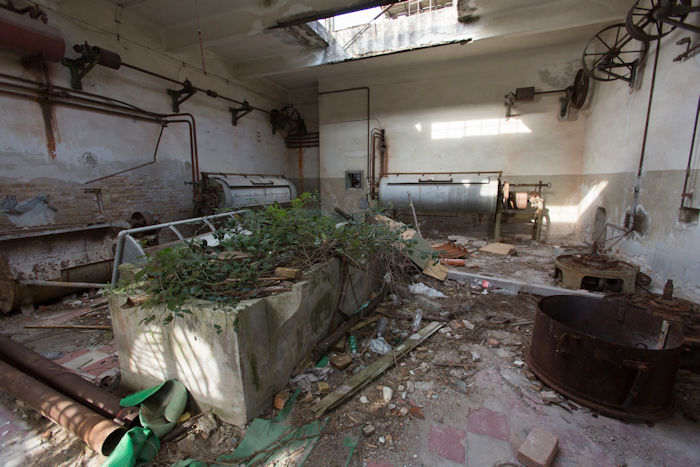Mystery Of The Bloody Island Poveglia – A Place Of Hell In Ancient And Modern Times
Ellen Lloyd - AncientPages.com - Throughout history, this creepy island had a number o names. It has, for example, been called the bloody island, the island of madness, and the island of hell.
The mystery of the Island Poveglia dates back to the 5th century. Today, the island is no longer inhabited.
No one visits it, and fishermen even steer clear of the island for fear of catching human bones in their nets. This dark place has for decades inspired superstitious terror into people's hearts.
Located off the coast of Venice, Italy, Poveglia Island is one of the world's darkest and most evil places. According to legend, the island was formed from the ashes of burned plague victims, criminals, and people with mental health conditions who were exiled there.
Aerial view of the plagued ghost island of Poveglia in the Venetian lagoon, opposite Malamocco along the Canal Orfano near Venice, Italy. Credit: Ingusk - Adobe Stock
The dark history of Poveglia Island began during the Roman Era when it was used to isolate plague victims from the general population.
Centuries later, when the Black Death rolled through Europe, it served that purpose again.
The dead were dumped into large pits and buried or burned.
As the plague tightened its grip, the population began to panic. Those residents showing the slightest sign of sickness were taken from their homes to the island of Poveglia, kicking, screaming, pleading.
They were thrown onto piles of rotting corpses and set ablaze. Men, women, and children were all left to die in agony.
Napoleon also used the island for a darker purpose and stored weapons there.
In 1922, a mental hospital was opened on Poveglia. Local legend says that one doctor at the hospital tortured and killed many of his patients, butchering them horribly only to later die by falling from, or possibly being thrown off of, its bell tower. His death remains a mystery to this day.
Over time, the island became a cemetery. Dead people were brought here to be burned or buried in mass graves. Researchers have suggested that more than 200,000 people are buried here.
All these events led to the belief that the island was haunted.
Poveglia Island. Credit: Jean-Patrick - Adobe Stock
People reported seeing ghosts of plague victims and hearing horrifying screams of tortured patients. The horrible place became known as the cursed island.
Today, Poveglia Island remains strictly off-limits to visitors. The Italian tourism board prohibits visiting the island (on paper) and requires a lengthy application process, where you must obtain approval before stepping on the island.
If you want, you can still get there by boat, but the question is whether you like to visit the final restless place of thousands of diseased, murderous, and insane people…
Written by Ellen Lloyd – AncientPages.com
First version of this article was originally published on November 24, 2014
Updated on September 11, 2022
Copyright © AncientPages.com All rights reserved. This material may not be published, broadcast, rewritten or redistributed in whole or part without the express written permission of AncientPages.com
More From Ancient Pages
-
 Discovery Of World’s Oldest Fortresses Reshapes Our Understanding Of Hunter–Gatherers
Archaeology | Dec 7, 2023
Discovery Of World’s Oldest Fortresses Reshapes Our Understanding Of Hunter–Gatherers
Archaeology | Dec 7, 2023 -
 Unsolved Mystery Of The Aleppo Codex And Its Missing Pages: One Of The World’s Most Precious Ancient Books
Artifacts | Feb 27, 2017
Unsolved Mystery Of The Aleppo Codex And Its Missing Pages: One Of The World’s Most Precious Ancient Books
Artifacts | Feb 27, 2017 -
 Mystery Of The Black Irish People: Who Were They?
Civilizations | May 24, 2016
Mystery Of The Black Irish People: Who Were They?
Civilizations | May 24, 2016 -
 Mystery Of The Österödskvinnan (Österöd Woman) Who Lived In Sweden 10,000 Years Ago
Featured Stories | Nov 6, 2023
Mystery Of The Österödskvinnan (Österöd Woman) Who Lived In Sweden 10,000 Years Ago
Featured Stories | Nov 6, 2023 -
 Elusive Planet Mercury As Seen Through The Eyes Of Ancient Astronomers
Archaeoastronomy | Dec 31, 2018
Elusive Planet Mercury As Seen Through The Eyes Of Ancient Astronomers
Archaeoastronomy | Dec 31, 2018 -
 Unique Historical Discovery – Wreck Of Vasa’s Sister Ship Äpplet Found Off Swedish Coast!
Archaeology | Oct 25, 2022
Unique Historical Discovery – Wreck Of Vasa’s Sister Ship Äpplet Found Off Swedish Coast!
Archaeology | Oct 25, 2022 -
 13,000-Year-Old Engraving May Depict First Paleolithic Social Group Of Humans
Archaeology | Dec 4, 2015
13,000-Year-Old Engraving May Depict First Paleolithic Social Group Of Humans
Archaeology | Dec 4, 2015 -
 Exceptionally Rare 1,300-Year-Old Golden Pommel Found In Blairdrummond, Scotland
Archaeology | Nov 1, 2022
Exceptionally Rare 1,300-Year-Old Golden Pommel Found In Blairdrummond, Scotland
Archaeology | Nov 1, 2022 -
 Uncovering Ancient Secrets Hidden In China’s Dunhuang Caves
News | Jan 13, 2021
Uncovering Ancient Secrets Hidden In China’s Dunhuang Caves
News | Jan 13, 2021 -
 Supay: God Of Death And Underworld And Ruler Over Race Of Demons According To Inca Beliefs
Featured Stories | Jun 7, 2020
Supay: God Of Death And Underworld And Ruler Over Race Of Demons According To Inca Beliefs
Featured Stories | Jun 7, 2020 -
 Humans May Be The Result Of An Evolution ‘Accident’- Scientists Say
Evolution | Sep 8, 2023
Humans May Be The Result Of An Evolution ‘Accident’- Scientists Say
Evolution | Sep 8, 2023 -
 Riddle Of The Ancient Lost City Beneath Missouri – A Puzzling Discovery
Civilizations | Mar 21, 2022
Riddle Of The Ancient Lost City Beneath Missouri – A Puzzling Discovery
Civilizations | Mar 21, 2022 -
 Drought Triggered Civil Conflict Among The Ancient Maya – Study
Archaeology | Jul 20, 2022
Drought Triggered Civil Conflict Among The Ancient Maya – Study
Archaeology | Jul 20, 2022 -
 Mysterious Grave Of King Valdemar IV Atterdag – Will The 600-Year-Old Historical Puzzle Ever Be Solved?
Featured Stories | Jul 14, 2018
Mysterious Grave Of King Valdemar IV Atterdag – Will The 600-Year-Old Historical Puzzle Ever Be Solved?
Featured Stories | Jul 14, 2018 -
 Wooden Coffin With Greco-Roman Mummy Wearing Mask Depicting Sky God Discovered In Egypt
Archaeology | Nov 17, 2017
Wooden Coffin With Greco-Roman Mummy Wearing Mask Depicting Sky God Discovered In Egypt
Archaeology | Nov 17, 2017 -
 Legend Of Brigadoon: Mythical Village Where Time Stands Still
Featured Stories | Nov 2, 2016
Legend Of Brigadoon: Mythical Village Where Time Stands Still
Featured Stories | Nov 2, 2016 -
 Catherine Of Valois – Scandalous Queen Who Caused Drama Even After Her Death
Featured Stories | Feb 4, 2019
Catherine Of Valois – Scandalous Queen Who Caused Drama Even After Her Death
Featured Stories | Feb 4, 2019 -
 15,000-Year-Old Shell Beads Found Kebara Cave Are The Oldest Known Use Of Organic Red Pigments
Archaeology | Oct 27, 2023
15,000-Year-Old Shell Beads Found Kebara Cave Are The Oldest Known Use Of Organic Red Pigments
Archaeology | Oct 27, 2023 -
 Mysterious Gosford Glyphs: Remarkable Ancient Egyptian Hieroglyphs Discovered In Australia Could Re-Write History
Featured Stories | Feb 20, 2020
Mysterious Gosford Glyphs: Remarkable Ancient Egyptian Hieroglyphs Discovered In Australia Could Re-Write History
Featured Stories | Feb 20, 2020 -
 Clovis People Invented ‘Fluting’ Ancient Stone Weaponry
Archaeology | Apr 5, 2017
Clovis People Invented ‘Fluting’ Ancient Stone Weaponry
Archaeology | Apr 5, 2017




